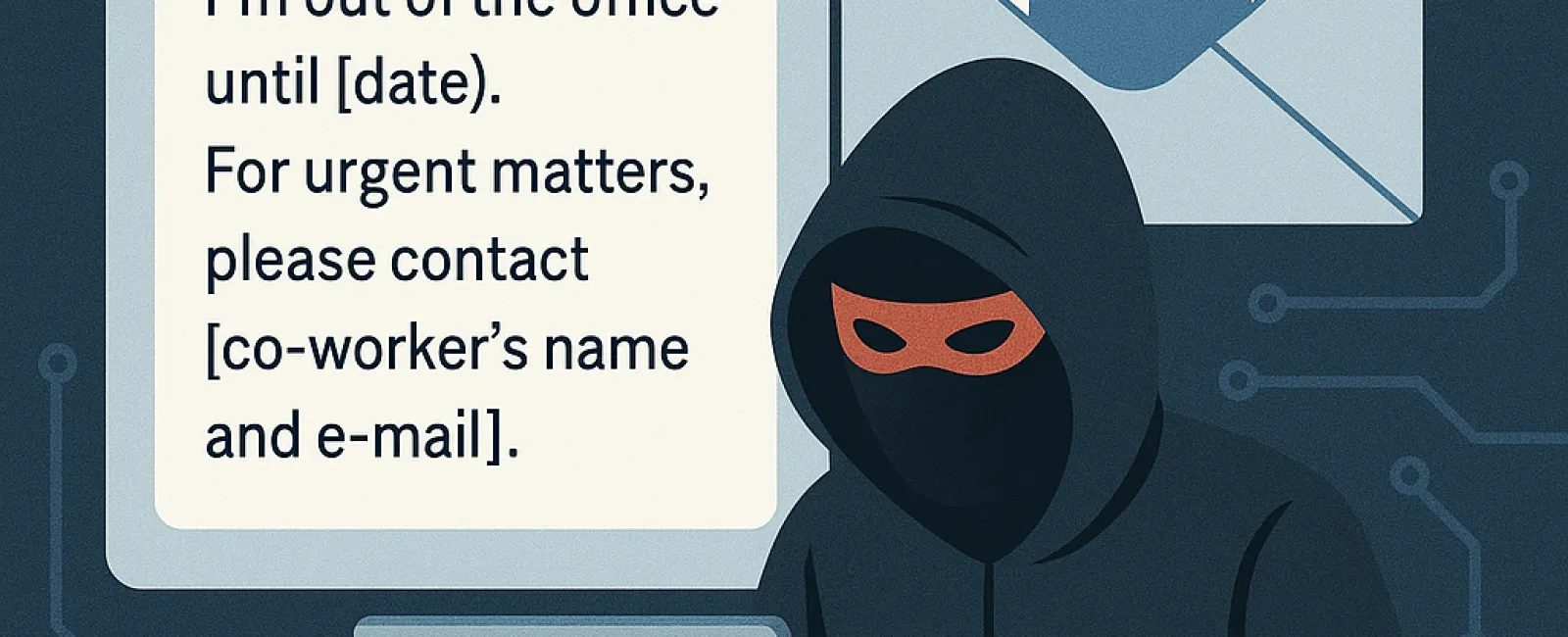June 11, 2025
You set it. You forget it. And just like that, while
you're packing for vacation, your inbox starts automatically broadcasting:
"Hi there! I'm out of the office until [date]. For
urgent matters, please contact [coworker's name and e-mail]."
Sounds
harmless, right? Convenient, even.
Except…that's
exactly what cybercriminals love to see.
Your auto-reply - the simple message meant to keep
things organized and moving smoothly - is also a gold mine of intel for bad
actors looking for an easy way in.
Let's break it down. A typical OOO message might
include:
● Your name and title
●
Dates you're unavailable
● Alternate contacts (with
their e-mail addresses)
● Internal team structures
●
Even details about why you're gone ("I'm at a
conference in Chicago…")
This
gives cybercriminals two major advantages:
1. Timing: They now know you're unavailable and less likely to notice suspicious activity.
2. Targeting: They know
exactly who to impersonate - and who to target with the scam.
That's the foundation for a perfect phishing or
business e-mail compromise (BEC) attack.
How The Scam
Usually Plays Out
Step 1: Your auto-reply message is sent.
Step 2: A hacker uses it to impersonate you
or the alternate contact you listed.
Step 3: They send an "urgent" e-mail
requesting a wire transfer, password or sensitive document.
Step 4: Your coworker, caught off guard,
assumes it's legit.
Step 5: You come back from vacation to find
out someone sent $45,000 to "a vendor."
This happens more frequently than you might think, and
it is even riskier for businesses that travel.
If your company has staff who travel often, especially
executives or sales teams, and someone else handles communications while
they're away (like a personal assistant or office admin), this creates prime
conditions for cybercriminals:
● The admin is fielding e-mails
from multiple people
●
They're used to handling payments, documents or
sensitive requests
●
They're working fast, trusting the people they think
they're hearing from
One
well-crafted fake e-mail can slip through - and suddenly your business is
dealing with a costly breach or fraud incident.
How To Protect Your Business From
Auto-Reply Exploits
The solution isn't to ditch OOO replies altogether - it's
to use them wisely and put safeguards in place. Here are a few
suggestions:
1. Keep It Vague
Skip the detailed itinerary. Don't list who's covering
for you unless it's absolutely necessary.
Example: "I'm currently out of the office and will
respond to your message when I return. If you need immediate assistance, please
contact our main office at [main contact info]."
2. Train Your Team
Make
sure your staff knows:
● Never act on urgent requests
involving money or sensitive info based on e-mail alone
● Always verify unusual
requests through a second channel (like a phone call)
3. Implement E-mail Security Tools
Utilize
advanced e-mail filters, anti-spoofing measures and domain protection to
minimize the likelihood of impersonation attacks reaching your inbox.
4. Use MFA Everywhere
Multifactor
authentication (MFA) should be enabled across all e-mail accounts. Even if a
hacker obtains a password, it prevents them from gaining access.
5. Work With An IT Partner Who Monitors Activity
A proactive IT and cybersecurity partner can detect
login attempts, phishing attacks and abnormal behavior before damage is
done.
Want To Vacation Without Becoming A
Hacker's Next Target?
We help businesses build cybersecurity systems that
work - even when your team's out of office.
Click Here To Book A
FREE Security Assessment.
We'll
check your systems for vulnerabilities and show you how to lock down the risks,
so you can actually enjoy that vacation without worrying about your inbox
betraying you.

